Elaeis guineensis

|
|
Elaeis guineensis Common Names: African Oil Palm, Red Oil Palm, Oil Palm Scientific
Classification Kingdom: Plantae Clade: Tracheophytes Clade: Angiosperms Clade: Monocots Clade: Commelinids Order: Arecales Family: Arecaceae Genus: Elaeis Species: E. guineensis Binomial Name: Elaeis guineensis Jacq. Synonyms: Elaeis dybowskii Hua, Elaeis macrophylla A.Chev. (nom. inval.), Elaeis madagascariensis (Jum. & H.Perrier) Becc., Elaeis melanococca Gaertn., Elaeis nigrescens (A.Chev.) Prain (nom. inval.), Elaeis virescens (A.Chev.) Prain, Palma oleosa Mill. Morphological Description Elaeis guineensis is a single-stemmed palm, growing 20–30 m tall in the wild,
shorter (10–15 m) in cultivation. Key features include: · Leaves: Pinnate, feathery, 3–5 m long, with 100–150 leaflets (each
60–120 cm), dark green · Flowers: Small, yellow, in dense male and female inflorescences,
pollinated by insects · Fruit: Drupes, 3–5 cm long, reddish-orange when ripe, in bunches of
200–300, weighing 10–40 kg · Seed: Single kernel, 1–2 cm, encased in a hard endocarp, yielding
palm kernel oil The fruit’s oily
mesocarp provides palm oil, a key economic product (Fern, 2023). Distribution and Habitat Elaeis guineensis thrives in: · Native Range: West Africa (Guinea to Angola), in rainforests and swampy
areas · Cultivated Range: Southeast Asia (Malaysia, Indonesia),
Central/South America, India · Habitat: Tropical rainforests, riverbanks, wetlands; prefers 25–30°C,
rainfall 1,500–2,500 mm · Soil: Deep, loamy, well-drained, pH 4–6 · Elevation: Sea level to 500 m It dominates global palm
oil production, especially in Malaysia and Indonesia (Okolo et al., 2019). Ethnopharmacology Elaeis guineensis (African oil palm) is a highly valuable medicinal plant
with various therapeutic properties due to its rich composition of
antioxidants, flavonoids, tocotrienols, carotenoids, sterols, and essential
fatty acids. It is widely known for its anti-inflammatory, antimicrobial,
antioxidant, cardioprotective, neuroprotective, wound-healing, and
hepatoprotective effects.The palm oil extracted from its fruits is a rich
source of tocotrienols and carotenoids, which have antioxidant properties that
help combat oxidative stress, support cardiovascular health, and may have
potential anticancer effects. It also contains healthy fats that support brain
function and reduce the risk of neurodegenerative diseases. The kernel oil has
antimicrobial and antifungal properties and is traditionally used to treat skin
infections, wounds, and burns. Additionally, the plant's roots and leaves are
used in traditional medicine for managing malaria, high blood pressure, and
gastrointestinal issues. Palm oil has been studied for its ability to improve
cholesterol levels, support liver function, and enhance immune system activity.
However, while it has many health benefits, excessive consumption of processed
palm oil may contribute to health risks such as increased cholesterol and heart
disease. Proper use and further scientific research are necessary to maximize
its medicinal potential safely. Wounds: Leaf juice in Ghana heals cuts; enhances
tissue regeneration (Sasidharan et al., 2010). · Skin Ailments: Palm oil in Nigeria treats rashes; antibacterial
against Staphylococcus aureus (MIC 0.5 mg/mL) (Owoyele & Owolabi, 2014). · Gonorrhea: Root decoction in Nigeria; traditional use lacks modern
validation (PROTA, 2019). · Headaches: Fruit oil in Côte d’Ivoire; analgesic in rats (40% reduction
at 200 mg/kg) (Rajoo et al., 2021). · Laxative: Sap in Cameroon; increases motility in vitro (Owoyele &
Owolabi, 2014). · Anti-inflammatory: Leaf extract in Benin; reduces edema (45%
at 300 mg/kg) (Uwamusi, 2024). ⚠ Toxicity Profile: No acute toxicity (LD₅₀ > 5,000 mg/kg in
rats); prolonged high-dose oil intake may increase cardiovascular risk due to
saturated fats (40–50% palmitic acid). Safe in moderation (Tow et al., 2021). Additional Information · Economic Importance: Supplies 35% of global vegetable oil; used
in food (margarine, snacks), cosmetics, biofuels (Okolo et al., 2019). · Ecological Impact: Deforestation for plantations reduces
biodiversity; sustainable practices emerging (Cosiaux et al., 2016). · Other Uses: Leaves for thatch, sap fermented into palm wine (5–6%
alcohol), kernels for animal feed (Fern, 2023). · Cultivation: Yields 3–5 tons oil/ha annually, peaking at 8–15 years
(PROTA, 2019). References
External Links More Pictures |
|
| Compounds of Elaeis guineensis | |
| References |